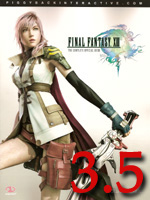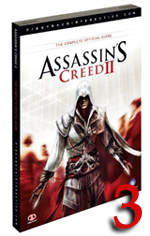I think everyone pretty much knew that I was going to declare the Assassin’s Creed: Brotherhood Collector’s Edition Strategy Guide as the cover of the week, so this should be no surprise. However, I thought perhaps a nice unboxing photo gallery would be far more fun (or annoying) to show off Prima Games’ and Piggyback Interactive’s latest piece of beauty.
[Read more…]
Search Results for: piggyback
Final Fantasy XIII Strategy Guide review
 Strategy Guide Review Policy:
Strategy Guide Review Policy:
My goal for these strategy guide reviews is not to discuss whether one needs the guide to complete the game. Every gamer has different strengths and skills, and one may need every bit of a guide, another may need to look up information for quick assistance once, and another may laugh at the idea of ever using a guide, even the online freebies. My goal is to determine whether the guide is 1) helpful in the first place, 2) does it encompass gamers who need hand-holding as well as those who need a quick reference and 3) how much information does it really have.
Review:
I can’t lie. This guide was really, really, REALLY hard for me to review. It does so many things well, and yet, when one would need it most, it utterly fails.
I mentioned a few weeks ago that the guide wasn’t fully informative when it came to the Chapter 9 boss, and that I’m certain (with verification from other friends) that defeating the boss with this strategy is downright impossible. Unfortunately, this wasn’t the only time the guide delivered a seemingly impossible strategy for fighting a boss. On the flipside, the other strategies worked flawlessly. Hence the quandary.
The other major issue I had was the guide’s party recommendations. With the Mark Missions, the guide simply suggests what roles are needed to successfully complete the mission. So in many ways, players can pick and choose which characters work best for them, not unlike they would in Final Fantasy III. The guide should have taken the same approach throughout the main quest. For the first 30 hours or so, players have no choice when it comes to their party as the characters are all divvied up. But when everyone is together, the guide strongly urges players to use a party consisting of Lightning, Fang, and Hope, and well, Hope just does not work very well. He’s not a great healer, his HP is incredibly low, and he moves so darn slowly. The guide suggests this party formation so that players have access to all different roles, and that’s all very good in theory but it doesn’t work well. The times one needs a Synergist role is so rare that it’s unnecessary to keep Hope in at all times. Not only that, but players could also simply apply a Fortisol or Aegisol before battle and it will do the same trick (and much faster as well). Maybe some players like working with Hope, and that’s fine, but the guide should have kept the same formula with the Mark Missions and not have “forced” a party selection on the player. This is also part of the problem I had with some of the boss fights I mentioned above. Once I changed out my characters to better suit my style of play, the guide hasn’t been all that useful to me for boss fights, and sadly enough, I’m doing much better and killing off bosses in one go.
Despite these setbacks, the guide does several other things really, really well. For instance, the maps are FLAWLESS. All treasure spheres are accounted for, all hidden doorways are marked, and all cut scenes are neatly designated. These maps are quite possibly some of the best maps I have ever come across in my guide-using days. In addition, the tips it provides for fattening up your Gil wallet, upgrading and dismantling weapons, and—everyone’s favorite RPG topic—level grinding, somewhat balances out the guide’s shortcomings. And as mentioned above, the strategies for enemies and most of the strategies for bosses were spot on.
It’s just unfortunate that the bosses it misses are the biggest, most important bosses in the game. It’s equally as unfortunate than none of the strategies provided will guarantee the player to earn a 5-star rating in battles and missions. The guide opted to make sure the player stays safe over annihilating the enemy as quickly and stylishly as possible, so for the most part, if you want those 5-stars, you’re on your own.
Perhaps now you see why I struggled with the final rating of 3.5/5 for PrimaGames and Piggyback Interactive’s Final Fantasy XIII Strategy Guide. It’s definitely above average, but it doesn’t wholly excel either.
Assassin’s Creed 2 Strategy Guide review
 Strategy Guide Review Policy:
Strategy Guide Review Policy:
My goal for these strategy guide reviews is not to discuss whether one needs the guide to complete the game. Every gamer has different strengths and skills, and one may need every bit of a guide, another may need to look up information for quick assistance once, and another may laugh at the idea of ever using a guide, even the online freebies. My goal is to determine whether the guide is 1) helpful in the first place, 2) does it encompass gamers who need hand-holding as well as those who need a quick reference and 3) how much information does it really have.
Review:
This is my first time to deal with a guide from Piggyback Interactive, and I really was not that impressed. While I am willing to admit that this game would definitely not be the easiest to write a guide for, it still doesn’t change the fact that I found most of the guide’s walkthroughs to be unusable.
The guide’s biggest flaw is its design. It’s very artistic and very appealing to the eyes, but while this is very conducive for an artbook, it most definitely is not for a strategy guide. For example, the guide only offers maps of the cities Ezio visited, but provides no maps for any of the walkthroughs, which in many instances, would have been more than helpful and/or welcome. Instead, the guide heavily relies on screenshots to show the player where they should be heading or what they should be looking for. These are occasionally helpful, like in the Assassin’s Tombs, but during missions, they are mostly extremely frustrating and oftentimes provide no assistance.
To make matters worse, the screenshots provided are extremely small, which do not help in deciphering the locations the writers refer to. The screenshots are so small in order to accommodate the other artwork on the pages that had nothing to do with offering a strategy. The artwork should have been replaced with the screenshots themselves, and then the tiny screenshots could have been replaced with maps that detail at least a red path of where Ezio travels in this particular memory. Some of the artwork could still have been used to keep the pages esthetically pleasing, but most of it should have gone in the back as a bonus artbook section.
The guide’s final problem in design lies in its table of contents. The table of contents in the front lists only five sections, and none of these sections are detailed as to what they contain. If you want to find out, you have to flip through the book and use the vertical “tabs” on the outside edge of the pages to find what you are looking for. Again, while this is artistic, it does not help players quickly find what they are looking for. If they want to look up the Achievements or Trophies they can obtain, users will first have to guess if these are listed in the Secrets section or in the Reference section, and then when they get to either section, they will still have to flip through it to find where the Achievements are. As a result, no quick look-up is as quick as it should be.
Fortunately, the writing in the walkthroughs for the most part is simple enough to understand and follow (it was only in a few spots that I had no idea–and still don’t know–what they were talking about), so I could piece together what they recommended Ezio do. Note the words, piece together. While I could usually understand what the writers were trying to convey, the words and directions were often quite vague, even in the sections where the writers provide additional and a deeper strategy, forcing me to rely on myself and what I could see anyway. That’s kind of not the point of a guide. Once again, maps for these missions would have cleared this up.
Now where the guide excels is in the Bonus material. It provides additional maps of each city that detail all the feathers and glyphs and a tear-out giant map that has all the cities with their feathers, glyphs, codex pages, and viewpoints clearly labeled. When I went glyph hunting at one point in the game, I heavily relied on these maps, and they were wonderful. Not only do they label where each feather and glyph were, but they provide screenshots of their locations. As anyone who has hunted feathers and glyphs knows, these are in some funky spots.
The guide also (fortunately for me) has in-depth solutions for each TRUTH puzzle that accompanies the glyphs. I only have one complaint about these solutions, and I fully admit that I’m being nit-picky with it. I really wish that the solutions included explanations for the passcode puzzles. I was able to understand the first couple of these, but after a certain point, I had no idea how to solve them or how these solutions made sense. Just a little nudge in why the passcode is what it is would have been nice for my inquisitive mind.
The biggest bonus that the guide offers (aside from all the pretty, pretty artwork and character designs) is the summary and analysis of the first game as well as the second. It summarizes the plot points of both games, explains each glyph left behind by Subject 16 in the first game, summarizes the second game, explains the cut scenes (such as the big cut scene with Altair and Maria in the middle of AC2), explains the TRUTH, and contains a FAQ session regarding the rather unusual and puzzling ending. While I admit that these are the writers’ own personal thoughts, most likely fueled by hints from Ubisoft, it still helped me wrap my mind around the ending sequences and what is in store for the future of the series.
The secrets that the guide unveils definitely saves it from being completely useless. It’s actually quite unfortunate that the design of the guide detracts from its usefulness so completely. The writing, while rather vague, is mostly fine, but if it only had clearer and larger screenshots as well as individual maps for the walkthroughs, it would not have been nearly as confusing. Due to this weak combination, I ended up not really using the walkthrough sections at all unless I really got lost and mostly used the guide for finding and deciphering glyphs.
Thus, Assassin’s Creed 2: The Complete Official Guide receives a 3/5.
- « Previous Page
- 1
- …
- 6
- 7
- 8